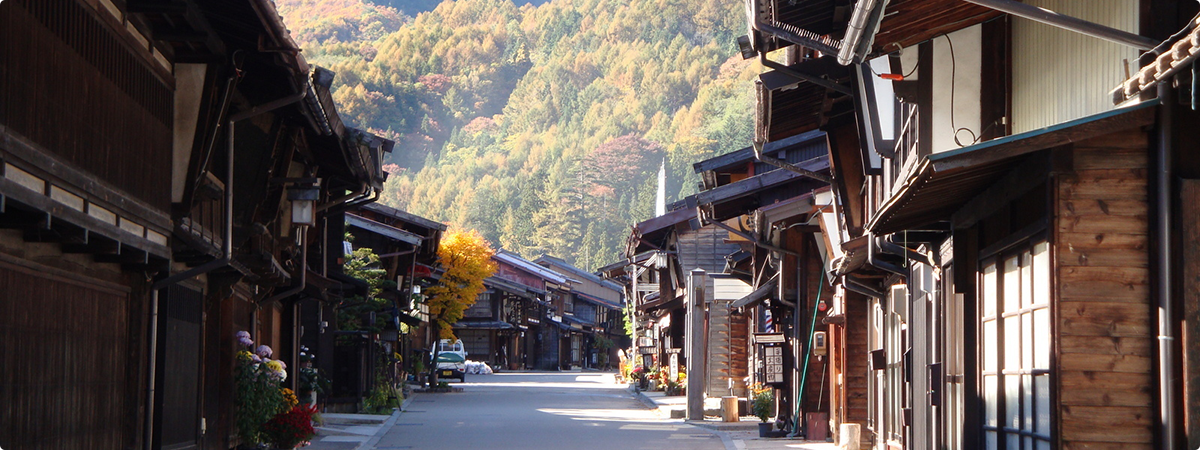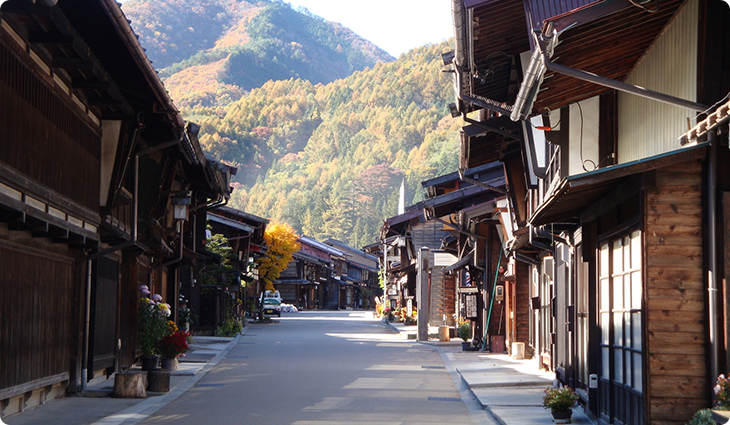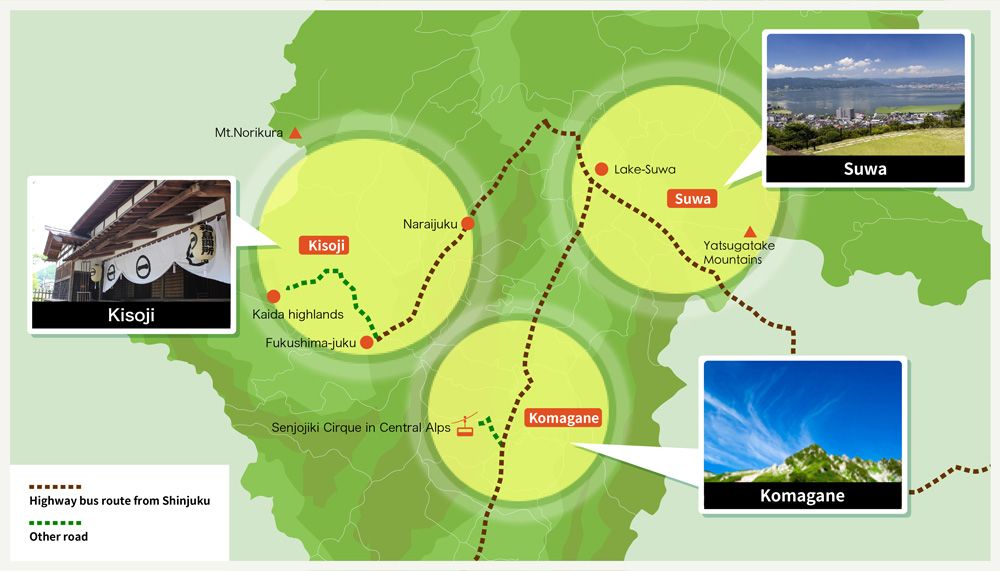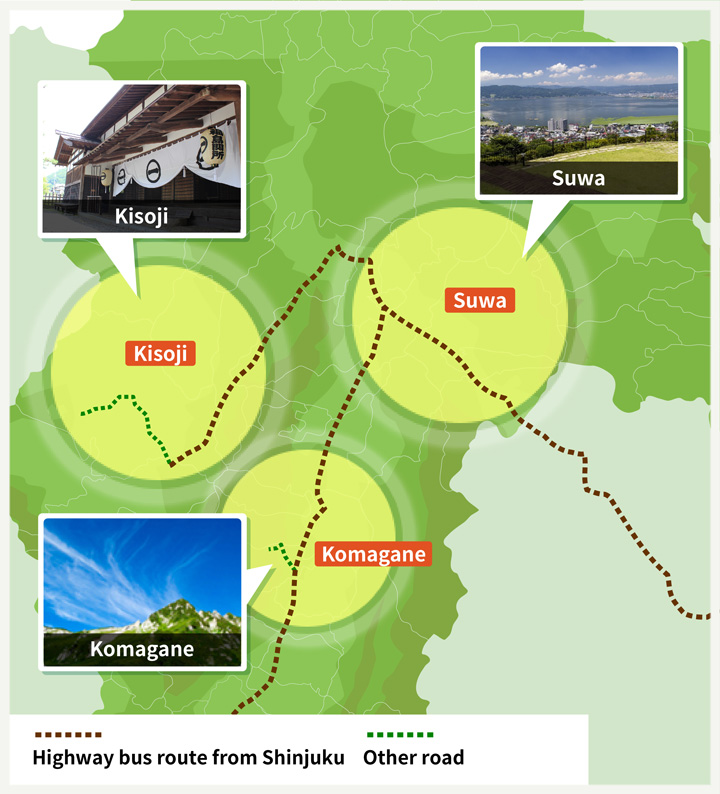

Tourist information on Kiso・Komagane・Suwa Area

This area is located in the southern part of Nagano Prefecture.
Kiso is between Ontake mountains and the Central Alps. There are eleven post towns such as Narai-juku where you can feel the atmosphere of the Edo period in the road along Kiso river.
It’s possible to overlook magnificent figures of the both Southern and Central Alps from the town of Komagane located in the base of Mt. Komagatake.
Suwa area is surrounded by the Yatsugatake Mountains on the northeast and by the Southern Alps on the southwest and the landscape with mountains and lakes centered on Lake Suwa is called “Oriental Switzerland”.
Kisoji
The Nakasendo Road is one of the 5 Roads in the Edo Period, stretched from Edo to Kyoto. On the rugged Kiso section called Kisoji, 11 post stations were established, flourishing since ancient times with many travelers. Enjoy the nostalgia and warmth of the relaxed atmosphere that remains to this day.
From Shinjuku; take “Kiso Fukushima Line” on Chuo highway bus

The second from the north among the 11 post stations of Kisoji, Narai-juku where townscape is formed along Narai River for about 1 km was the longest post station in Japan. It is a sightseeing spot where lanterns and old style lattices, etc. of inns of the Edo period and Japanese emotions
【Access】From Shinjuku; take “Kisofukushima Line” on Chuo highway bus, get off at “Narai-juku”

The fifth from the north among the 11 post stations of Kisoji, Fushima-juku where the checkpoint were established in Edo period, has been prosperous since ancient times as a large-scale post station. There is a harmony between the old-fashioned architecture and the watering place that dates from the Edo period. As evening falls, paper-covered lanterns are lit, and can be enjoyed throughout the year.
【Access】From Shinjuku; take “Kisofukushima Line” on Chuo highway bus, get off at “Fukushima-Sekisho”

The Kaida highlands where the birthplace of Kiso horses, are a refreshing plateau ranging from 1,100 to 1,300 meters in elevation with cool summer temperatures of around 18 degrees. Beautiful views of the majestic Mt. Ontake can be enjoyed from various locations around the highlands.
【Access】From Shinjuku; take “Kisofukushima Line” on Chuo highway bus, get off at “Fukushima Station”, transfer to route bus “Kaida Kougen Line”
- Kiso Town Tourism Association “Kanko-Kiso.com”
- Information about route bus “Kaida Kougen Line”
※Japanese Website only
Komagane
Komagane is located between two Japan Alps, Southern and Central. Ina Valley is very popular tourist spot with numerous spectacular sceneries. It is a popular tourist spot where you can enjoy climbing and walking while watching the scenery of the seasons.
From Shinjuku; take “Ina-Iida Line” on Chuo highway bus

Senjojiki Cirque in Central Alps located at an elevation of 2,612 meters at the end of the Komagatake Ropeway is the most famous cirque in Japan, and is known as treasure house of alpine plants. It spreads just under the rocky mountains of the alpine belt that exceeds 2,500 m in altitude, and is famous for skiing in the spring, pretty alpine plants in the summer, autumn leaves in the fall, the azure sky and pure white snow in winter. A lot of mountaineers and tourists visit from all over the country seeking magnificent beautiful scenery that changes dynamically every season with contrast.
Senjojiki Station stands at the highest elevation of any station in Japan (2,612 meters), while Shirabidaira station located at the base of Central Alps Komagatake Ropeway is found at 1,662 meters. This elevation gain of 950 meters is the largest of any ropeway in Japan.
【Access】From Shinjuku; take “Ina-Iida Line” on Chuo highway bus, get off at “Komagane Bus Terminal” or “Komagane IC”. Take the route bus “Komagatake Ropeway Line”, get off at “Shirabidaira Station” and transfer to “Komagatake Ropeway”.
- Go Nagano! Nagano Prefecture Official Tourism Guide
- Information about route bus
※Japanese Website only
Suwa
Suwa is, the home territory of Suwa Shrine, located at the confluence of the two highways of the Edo period, Koshu Kaido and Nakasendo, many historical buildings are still remained. In the vicinity of Lake Suwa, there is a cultural zone in which art museums, museums, parks, etc. are maintained. In the surrounding area, the famous plateau rises, such as the Kirigamine Plateau, Tateshina Kogen Plateau, Yatsugatake Central Plateau and Fujimi Kogen Plateau.
From Shinjuku; take “Suwa-Okaya Line” on Chuo highway bus

Lake Suwa located in the middle of the Suwa basin is the biggest lake in Shinshu. After taking a walk or jogging at the lake, you can enjoy the leisurely scenery with footbath and boat and fishing on the lake. The fireworks of Lake Suwa which will be held in August are full of powerfulness as they are surrounded by mountains. Approximately 40,000 fireworks in 2 hours will dyed one side of Suwa lively. “Star Mine” unique to Lake Suwa and “Niagara Falls” with a total length of about 2 km are must see.
【Access】From Shinjuku; take “Suwa-Okaya Line” on Chuo highway bus, get off at “Kamisuwa Station”

Yatsugatake straddling Nagano Prefecture and Yamanashi Prefecture are mountains of 30 km north and south where unique mountain ranges. It is divided into Minami (South) Yatsugatake where a sharp rocky peak of altitude 3000 m class including the main peak Akadake continues, and Kita (North) Yatsugatake where relatively gentle peaks covered with virgin forest, and mysterious lakes are scattered. It is a popular mountain climbing spot with easy access from the metropolitan area is also good, and you can enjoy the real pleasure of climbing even on a short schedule of two nights.
【Access】From Shinjuku; take “Suwa-Okaya Line” on Chuo highway bus, get off at “Chuo-do Chino”and, transfer to route bus from Chino Station.
Suwa local Tourism AssociationInformation of route bus
※Japanese Website only

